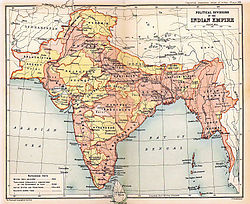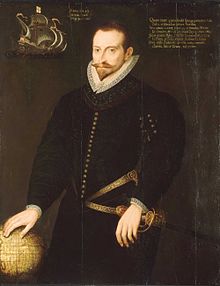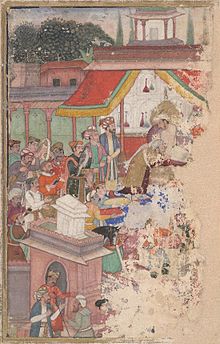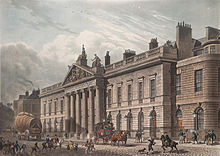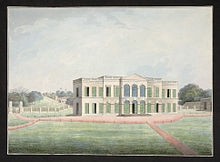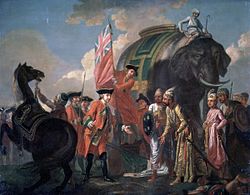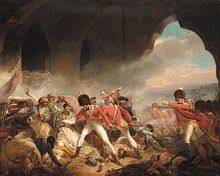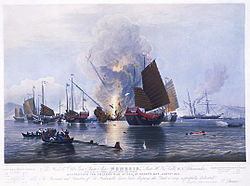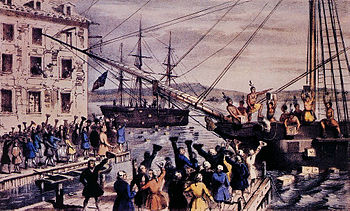
East India Company
About this schools Wikipedia selection
This wikipedia selection has been chosen by volunteers helping SOS Children from Wikipedia for this Wikipedia Selection for schools. Visit the SOS Children website at http://www.soschildren.org/
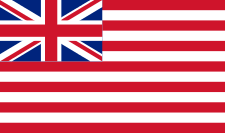 Company flag after 1801 |
|
| Former type | Public |
|---|---|
| Industry | International trade |
| Fate | Dissolved |
| Founded | 1600 |
| Defunct | June 1, 1874 |
| Headquarters | London, England |
The East India Company (EIC), originally chartered as the Governor and Company of Merchants of London trading into the East Indies, and often called the Honourable East India Company, was an English and later (from 1707) British joint-stock company and megacorporation formed for pursuing trade with the East Indies but which ended up trading mainly with the Indian subcontinent, North-west frontier province and Balochistan.
The East India Company traded mainly in cotton, silk, indigo dye, salt, saltpetre, tea and opium. The Company was granted a Royal Charter by Queen Elizabeth in 1600, making it the oldest among several similarly formed European East India Companies. Shares of the company were owned by wealthy merchants and aristocrats. The government owned no shares and had only indirect control. The Company eventually came to rule large areas of India with its own private armies, exercising military power and assuming administrative functions. Company rule in India effectively began in 1757 after the Battle of Plassey and lasted until 1858 when, following the Indian Rebellion of 1857, the Government of India Act 1858 led to the British Crown assuming direct control of India in the era of the new British Raj.
The Company was dissolved in 1874 as a result of the East India Stock Dividend Redemption Act passed one year earlier, as the Government of India Act had by then rendered it vestigial, powerless and obsolete. Its functions had been fully absorbed into the official government machinery of British India and its private Presidency armies had been nationalised by the British Crown.
Founding
Soon after the defeat of the Spanish Armada in 1588, London merchants presented a petition to Queen Elizabeth I for permission to sail to the Indian Ocean. The permission was granted and on 10 April 1591 three ships sailed from Torbay England around the Cape of Good Hope to the Arabian Sea and was one the earliest of the English overseas Indian expeditions. One of them, the Edward Bonventure, then sailed around Cape Comorin and on to the Malay Peninsula and subsequently returned to England in 1594.
In 1596, three more ships sailed east; however, these were all lost at sea. Two years later, on 24 September 1598, another group of merchants having raised 30,133 in capital, met in London to form a corporation. Although their first attempt was not completely successful, they nonetheless sought the Queen's unofficial approval, bought ships for their venture, increased their capital to 68,373, and convened again a year later.
This time they succeeded, and on 31 December 1600, the Queen granted a Royal Charter to " George, Earl of Cumberland, and 215 Knights, Aldermen, and Burgesses" under the name, Governor and Company of Merchants of London trading with the East Indies. For a period of fifteen years the charter awarded the newly formed company a monopoly on trade with all countries east of the Cape of Good Hope and west of the Straits of Magellan. Sir James Lancaster commanded the first East India Company voyage in 1601 and in March 1604 Sir Henry Middleton commanded the second voyage.
Initially, the Company struggled in the spice trade due to the competition from the already well established Dutch East India Company. The Company opened a factory in Bantam on the first voyage and imports of pepper from Java were an important part of the Company's trade for twenty years. The factory in Bantam was closed in 1683. During this time ships belonging to the company arriving in India docked at Surat, which was established as a trade transit point in 1608.
In the next two years, the Company built its first factory in south India in the town of Machilipatnam on the Coromandel Coast of the Bay of Bengal. The high profits reported by the Company after landing in India initially prompted King James I to grant subsidiary licenses to other trading companies in England. But in 1609 he renewed the charter given to the Company for an indefinite period, including a clause which specified that the charter would cease to be in force if the trade turned unprofitable for three consecutive years.
The Company was led by one Governor and 24 directors, who made up the Court of Directors. They, in turn, reported to the Court of Proprietors which appointed them. Ten committees reported to the Court of Directors.
Foothold in India
English traders frequently engaged in hostilities with their Dutch and Portuguese counterparts in the Indian Ocean. The Company achieved a major victory over the Portuguese in the Battle of Swally in 1612. The Company decided to explore the feasibility of gaining a territorial foothold in mainland India, with official sanction of both countries, and requested that the Crown launch a diplomatic mission.
In 1612, James I instructed Sir Thomas Roe to visit the Mughal Emperor Nuruddin Salim Jahangir (r. 1605 – 1627) to arrange for a commercial treaty that would give the Company exclusive rights to reside and build factories in Surat and other areas. In return, the Company offered to provide the Emperor with goods and rarities from the European market. This mission was highly successful as Jahangir sent a letter to James through Sir Thomas Roe:
"Upon which assurance of your royal love I have given my general command to all the kingdoms and ports of my dominions to receive all the merchants of the English nation as the subjects of my friend; that in what place soever they choose to live, they may have free liberty without any restraint; and at what port soever they shall arrive, that neither Portugal nor any other shall dare to molest their quiet; and in what city soever they shall have residence, I have commanded all my governors and captains to give them freedom answerable to their own desires; to sell, buy, and to transport into their country at their pleasure.
For confirmation of our love and friendship, I desire your Majesty to command your merchants to bring in their ships of all sorts of rarities and rich goods fit for my palace; and that you be pleased to send me your royal letters by every opportunity, that I may rejoice in your health and prosperous affairs; that our friendship may be interchanged and eternal"—Nuruddin Salim Jahangir, Letter to James I.
Expansion
The Company, benefiting from the imperial patronage, soon expanded its commercial trading operations, eclipsing the Portuguese Estado da India, which had established bases in Goa, Chittagong and Bombay (which was later ceded to England as part of the dowry of Catherine de Braganza). The East India Company also launched a joint effort attack with the Dutch United East India Company on Portuguese and Spanish ships off the coast of China, which helped secure their ports in China. The Company created trading posts in Surat (where a factory was built in 1612), Madras (1639), Bombay (1668), and Calcutta (1690). By 1647, the Company had 23 factories, each under the command of a factor or master merchant and governor if so chosen, and had 90 employees in India. The major factories became the walled forts of Fort William in Bengal, Fort St George in Madras, and the Bombay Castle.
In 1634, the Mughal emperor extended his hospitality to the English traders to the region of Bengal, and in 1717 completely waived customs duties for the trade. The company's mainstay businesses were by then in cotton, silk, indigo dye, saltpetre and tea. The Company's future, however, was braked by the signing of the Treaty of Münster in 1648, which freed the Netherlands from Spanish control allowing it to turn its full attention to expanding its trade both in home and distant waters and enter a period recognised as Holland's 'Golden Age'. The Dutch were aggressive competitors, and had meanwhile expanded their monopoly of the spice trade in the Malaccan straits by ousting the Portuguese in 1640–41. With reduced Portuguese and Spanish influence in the region, the EIC and Dutch East India Company (VOC) entered a period of intense competition, resulting in the Anglo-Dutch Wars of the 17th and 18th centuries.
Meanwhile, in 1657, Oliver Cromwell renewed the charter of 1609, and brought about minor changes in the holding of the Company, largely due to his reversal of the edict of expulsion after he beheaded the King, and reflecting his connections to Jewish Merchants.. The status of the Company was further enhanced by the restoration of monarchy in England.
In an act aimed at strengthening the power of the EIC, King Charles II provisioned the EIC (in a series of five acts around 1670) with the rights to autonomous territorial acquisitions, to mint money, to command fortresses and troops and form alliances, to make war and peace, and to exercise both civil and criminal jurisdiction over the acquired areas.
William Hedges was sent in 1682 to Shaista Khan, the Mughal governor of Bengal in order to obtain a firman, an imperial directive that would grant England regular trading privileges throughout the Mughal empire. However, the company's governor in London, Sir Josiah Child, interfered with Hedges's mission, causing Mughal Emperor Aurangzeb to break off the negotiations.
In 1689 a Mughal fleet commanded by Sidi Yakub attacked Bombay. After a year of resistance the EIC surrendered in 1690, and the company sent envoys to Aurangzeb's camp to plead for a pardon. The company's envoys had to prostrate themselves before the emperor, pay a large indemnity, and promise better behaviour in the future. The emperor withdrew his troops and the company subsequently reestablished itself in Bombay and set up a new base in Calcutta.
Mughal convoy piracy incident of 1695
In September 1695, Captain Henry Every, an English pirate on board the Fancy, reached the Straits of Bab-el-Mandeb, where he teamed up with five other pirate captains to make an attack on the Indian fleet making the annual voyage to Mecca. The Mughal convoy included the treasure-laden Ganj-i-Sawai, reported to be the greatest in the Mughal fleet and the largest ship operational in the Indian Ocean, and its escort, the Fateh Muhammed. They were spotted passing the straits en route to Surat. The pirates gave chase and caught up with the Fateh Muhammed some days later, and meeting little resistance, took some £50,000 to £60,000 worth of treasure.
Every continued in pursuit and managed to overhaul the Ganj-i-Sawai, who put up a fearsome fight but it too was eventually taken. The ship carried enormous wealth and, according to contemporary East India Company sources, was carrying a relative of the Grand Mughal, though there is no evidence to suggest that it was his daughter and her retinue. The loot from the Ganj-i-Sawai totalled between £325,000 and £600,000, including 500,000 gold and silver pieces, and has become known as the richest ship ever taken by pirates.
In a letter sent to the Privy Council by Sir John Gayer, then governor of Bombay and head of the East India Company, Gayer claims that "it is certain the Pirates...did do very barbarously by the People of the Ganj-i-Sawai and Abdul Ghaffar's ship, to make them confess where their money was." The pirates set free the survivors who were left aboard their emptied ships, to continue their voyage back to India.
When the news arrived in England it caused an out-cry. In response, a combined bounty of £1,000 (considered massive by the standards of the time) was offered for Every's capture by the Privy Council and East India Company, leading to the first worldwide manhunt in recorded history. The plunder of Aurangzeb's treasure ship had serious consequences for the English East India Company. The furious Mughal Emperor Aurangzeb ordered Sidi Yaqub and Nawab Daud Khan to attack and close four of the company's factories in India and imprison their officers, who were almost lynched by a mob of angry Mughals, blaming them for their countryman's depredations, and threatened to put an end to all English trading in India. To appease Emperor Aurangzeb and particularly his Grand Vizier Asad Khan, Parliament exempted Every from all of the Acts of Grace (pardons) and amnesties it would subsequently issue to other pirates.
In 1711, the Company was given permission by the Kangxi Emperor to enter Canton (Guangzhou), China, to trade tea for silver.
-
A British pirate encounters Muslim women from the Mughal Empire on board a captured vessel.
Forming a complete monopoly
Trade monopoly
The prosperity that the officers of the company enjoyed allowed them to return to Britain and establish sprawling estates and businesses, and to obtain political power. The Company developed a lobby in the English parliament. Under pressure from ambitious tradesmen and former associates of the Company (pejoratively termed Interlopers by the Company), who wanted to establish private trading firms in India, a deregulating act was passed in 1694.
This allowed any English firm to trade with India, unless specifically prohibited by act of parliament, thereby annulling the charter that had been in force for almost 100 years. By an act that was passed in 1698, a new "parallel" East India Company (officially titled the English Company Trading to the East Indies) was floated under a state-backed indemnity of £2 million. The powerful stockholders of the old company quickly subscribed a sum of £315,000 in the new concern, and dominated the new body. The two companies wrestled with each other for some time, both in England and in India, for a dominant share of the trade.
It quickly became evident that, in practice, the original Company faced scarcely any measurable competition. The companies merged in 1708, by a tripartite indenture involving both companies and the state. Under this arrangement, the merged company lent to the Treasury a sum of £3,200,000, in return for exclusive privileges for the next three years, after which the situation was to be reviewed. The amalgamated company became the United Company of Merchants of England Trading to the East Indies.
In the following decades there was a constant see-saw battle between the Company lobby and the Parliament. The Company sought a permanent establishment, while the Parliament would not willingly allow it greater autonomy and so relinquish the opportunity to exploit the Company's profits. In 1712, another act renewed the status of the Company, though the debts were repaid. By 1720, 15% of British imports were from India, almost all passing through the Company, which reasserted the influence of the Company lobby. The license was prolonged until 1766 by yet another act in 1730.
At this time, Britain and France became bitter rivals. Frequent skirmishes between them took place for control of colonial possessions. In 1742, fearing the monetary consequences of a war, the British government agreed to extend the deadline for the licensed exclusive trade by the Company in India until 1783, in return for a further loan of £1 million. Between 1756 and 1763, the Seven Years' War diverted the state's attention towards consolidation and defence of its territorial possessions in Europe and its colonies in North America.
The war took place on Indian soil, between the Company troops and the French forces. In 1757, the Law Officers of the Crown delivered the Pratt-Yorke opinion distinguishing overseas territories acquired by right of conquest from those acquired by private treaty. The opinion asserted that, while the Crown of Great Britain enjoyed sovereignty over both, only the property of the former was vested in the Crown.
With the advent of the Industrial Revolution, Britain surged ahead of its European rivals. Demand for Indian commodities was boosted by the need to sustain the troops and the economy during the war, and by the increased availability of raw materials and efficient methods of production. As home to the revolution, Britain experienced higher standards of living. Its spiralling cycle of prosperity, demand, and production had a profound influence on overseas trade. The Company became the single largest player in the British global market. It reserved for itself an unassailable position in the decision-making process of the Government.
William Henry Pyne notes in his book The Microcosm of London (1808) that:
- "On the 1 March 1801, the debts of the East India Company to £5,393,989 their effects to £15,404,736 and their sales increased since February 1793, from £4,988,300 to £7,602,041."
Saltpetre trade
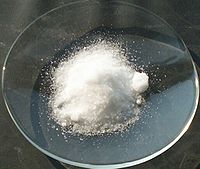
Sir John Banks, a businessman from Kent who negotiated an agreement between the King and the Company, began his career in a syndicate arranging contracts for victualling the navy, an interest he kept up for most of his life. He knew Samuel Pepys and John Evelyn and founded a substantial fortune from the Levant and Indian trades.
He became a Director and later, as Governor of the East Indian Company in 1672, he arranged a contract which included a loan of £20,000 and £30,000 worth of saltpetre — also known as potassium nitrate, a primary ingredient in gunpowder – for the King 'at the price it shall sell by the candle' — that is by auction — where an inch of candle burned and as long as it was alight bidding could continue. The agreement included with the price 'an allowance of interest which is to be expressed in tallies.' This was something of a breakthrough in royal prerogative because previous requests for the King to buy at the Company's auctions had been turned down as 'not honourable or decent.'
Outstanding debts were also agreed and the Company permitted to export 250 tons of saltpetre. Again in 1673, Banks successfully negotiated another contract for 700 tons of saltpetre at £37,000 between the King and the Company. So urgent was the need to supply the armed forces in the United Kingdom, America, and elsewhere that the authorities sometimes turned a blind eye on the untaxed sales. One governor of the Company was even reported as saying in 1864 that he would rather have the saltpetre made than the tax on salt.
Basis for the monopoly
Colonial monopoly
The Seven Years' War (1756–1763) resulted in the defeat of the French forces, limited French imperial ambitions, and stunting the influence of the industrial revolution in French territories. Robert Clive, the Governor General, led the Company to a victory against Joseph François Dupleix, the commander of the French forces in India, and recaptured Fort St George from the French. The Company took this respite to seize Manila in 1762.
By the Treaty of Paris (1763), France regained the five establishments captured by the British during the war ( Pondichéry, Mahe, Karikal, Yanam, and Chandernagar) but was prevented from erecting fortifications and keeping troops in Bengal (art. XI). Elsewhere in India, the French were to remain a military threat, particularly during the War of American Independence, and up to the capture of Pondichéry in 1793 at the outset of the French Revolutionary Wars without any military presence. Although these small outposts remained French possessions for the next two hundred years, French ambitions on Indian territories were effectively laid to rest, thus eliminating a major source of economic competition for the Company.
In contrast, the Company, fresh from a colossal victory, and with the backing of a disciplined and experienced army, was able to assert its interests in the Carnatic region from its base at Madras and in Bengal from Calcutta, without facing any further obstacles from other colonial powers.
Military expansion
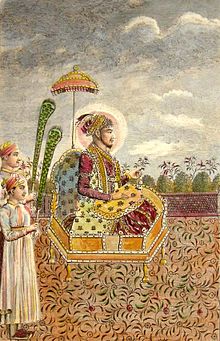
The Company continued to experience resistance from local rulers during its expansion. Robert Clive led company forces against Siraj Ud Daulah, the last independent Nawab of Bengal, Bihar, and Midnapore district in Odisha to victory at the Battle of Plassey in 1757, resulting in the conquest of Bengal. This victory estranged the British and the Mughals, since Siraj Ud Daulah was a Mughal feudatory ally.
With the gradual weakening of the Marathas in the aftermath of the three Anglo-Maratha wars, the British also secured Ganges-Jumna Doab, the Delhi-Agra region, parts of Bundelkhand, Broach, some districts of Gujarat, fort of Ahmmadnagar, province of Cuttack (which included Mughalbandi/the coastal part of Odisha, Garjat/the princely states of Odisha, Balasore Port, parts of Midnapore district of West Bengal), Bombay (Mumbai) and the surrounding areas, leading to a formal end of the Maratha empire and firm establishment of the British East India Company in India.
Hyder Ali and Tipu Sultan, the rulers of the Kingdom of Mysore, offered much resistance to the British forces. Having sided with the French during the war, the rulers of Mysore continued their struggle against the Company with the four Anglo-Mysore Wars. Mysore finally fell to the Company forces in 1799, with the death of Tipu Sultan.
The last vestiges of local administration were restricted to the northern regions of Delhi, Oudh, Rajputana, and Punjab, where the Company's presence was ever increasing amidst infighting and offers of protection among the remaining princes. Coercive action, threats, and diplomacy aided the Company in preventing the local rulers from putting up a united struggle. The hundred years from the Battle of Plassey in 1757 to the Indian Rebellion of 1857 were a period of consolidation for the Company, which began to function more as a nation and less as a trading concern.
A cholera pandemic began in Bengal, then spread across India by 1820. 10,000 British troops and countless Indians died during this pandemic. Between 1736 and 1834 only some 10% of East India Company's officers survived to take the final voyage home.
Opium trade
In the 18th century, Britain had a huge trade deficit with Qing Dynasty China and so in 1773, the Company created a British monopoly on opium buying in Bengal. As the opium trade was illegal in China, Company ships could not carry opium to China. So the opium produced in Bengal was sold in Calcutta on condition that it be sent to China.
Despite the Chinese ban on opium imports, reaffirmed in 1799 by the Jiaqing Emperor, the drug was smuggled into China from Bengal by traffickers and agency houses such as Jardine, Matheson & Co and Dent & Co. in amounts averaging 900 tons a year. The proceeds of the drug-smugglers landing their cargoes at Lintin Island were paid into the Company's factory at Canton and by 1825, most of the money needed to buy tea in China was raised by the illegal opium trade.
The Company established a group of trading settlements centred on the Straits of Malacca called the Straits Settlements in 1826 to protect its trade route to China and to combat local piracy. The Settlements were also used as penal settlements for Indian civilian and military prisoners.
In 1838, with the amount of smuggled opium entering China approaching 1,400 tons a year, the Chinese imposed a death penalty for opium smuggling and sent a Special Imperial Commissioner, Lin Zexu, to curb smuggling. This resulted in the First Opium War (1839–1842). After the war Hong Kong island was ceded to Britain under the Treaty of Nanking and the Chinese market opened to the opium traders of Britain and other nations. A Second Opium War fought by Britain and France against China lasted from 1856 until 1860 and led to the Treaty of Tientsin.
Regulation of the company's affairs
Writers
The Company employed many junior clerks, known as "writers", to record the details of accounting, managerial decisions, and activities related to the Company, such as minutes of meetings, copies of Company orders and contracts, and filings of reports and copies of ship's logs. Several well-known British scholars and literary men had Company writerships, such as Henry Thomas Colebrooke in India and Charles Lamb in England.
Financial troubles
Though the Company was becoming increasingly bold and ambitious in putting down resisting states, it was getting clearer that the Company was incapable of governing the vast expanse of the captured territories. The Bengal famine of 1770, in which one-third of the local population died, caused distress in Britain. Military and administrative costs mounted beyond control in British-administered regions in Bengal due to the ensuing drop in labour productivity.
At the same time, there was commercial stagnation and trade depression throughout Europe. The directors of the company attempted to avert bankruptcy by appealing to Parliament for financial help. This led to the passing of the Tea Act in 1773, which gave the Company greater autonomy in running its trade in the American colonies, and allowed it an exemption from tea import duties which its colonial competitors were required to pay.
When the American colonists, who included tea merchants, were told of the act, they tried to boycott it, claiming that although the price had gone down on the tea when enforcing the act, it also would help validate the Townshend Acts and set a precedent for the king to impose additional taxes in the future. The arrival of tax-exempt Company tea, undercutting the local merchants, triggered the Boston Tea Party in the Province of Massachusetts Bay, one of the major events leading up to the American Revolution.
Regulating Acts of Parliament
East India Company Act 1773
By the Regulating Act of 1773 (later known as the East India Company Act 1773), the Parliament of Great Britain imposed a series of administrative and economic reforms and by doing so clearly established its sovereignty and ultimate control over the Company. The Act recognised the Company's political functions and clearly established that the " acquisition of sovereignty by the subjects of the Crown is on behalf of the Crown and not in its own right."
Despite stiff resistance from the East India lobby in parliament and from the Company's shareholders the Act was passed. It introduced substantial governmental control and allowed the land to be formally under the control of the Crown, but leased to the Company at £40,000 for two years. Under this provision governor of Bengal Warren Hastings became the first Governor-General of Bengal, and had administrative powers over all of British India. It provided that his nomination, though made by a court of directors, should in future be subject to the approval of a Council of Four appointed by the Crown – namely Lt. General Sir John Clavering, The Honourable Sir George Monson, Sir Richard Barwell, and Sir Philip Francis.
Hastings was entrusted with the power of peace and war. British judicial personnel would also be sent to India to administer the British legal system. The Governor General and the council would have complete legislative powers. The company was allowed to maintain its virtual monopoly over trade in exchange for the biennial sum and was obligated to export a minimum quantity of goods yearly to Britain. The costs of administration were to be met by the company. These provisions were initially welcomed by the Company, but with the annual burden of the payment to be met, its finances continued steadily to decline.
East India Company Act 1784 (Pitt's India Act)
The East India Company Act 1784 ( Pitt's India Act) had two key aspects:
- Relationship to the British government: the bill differentiated the East India Company's political functions from its commercial activities. In political matters the East India Company was subordinated to the British government directly. To accomplish this, the Act created a Board of Commissioners for the Affairs of India, usually referred to as the Board of Control. The members of the Board were the Chancellor of the Exchequer, the Secretary of State, and four Privy Councillors, nominated by the King. The act specified that the Secretary of State "shall preside at, and be President of the said Board".
- Internal Administration of British India: the bill laid the foundation for the centralised and bureaucratic British administration of India which would reach its peak at the beginning of the 20th century during the governor-generalship of George Nathaniel Curzon, 1st Baron Curzon.
Pitt's Act was deemed a failure because it quickly became apparent that the boundaries between government control and the company's powers were nebulous and highly subjective. The government felt obliged to respond to humanitarian calls for better treatment of local peoples in British-occupied territories. Edmund Burke, a former East India Company shareholder and diplomat, was moved to address the situation and introduced a new Regulating Bill in 1783. The bill was defeated amid lobbying by company loyalists and accusations of nepotism in the bill's recommendations for the appointment of councillors.
Act of 1786
The Act of 1786 (26 Geo. 3 c. 16) enacted the demand of Earl Cornwallis that the powers of the Governor-General be enlarged to empower him, in special cases, to override the majority of his Council and act on his own special responsibility. The Act enabled the offices of the Governor-General and the Commander-in-Chief to be jointly held by the same official.
This Act clearly demarcated borders between the Crown and the Company. After this point, the Company functioned as a regularised subsidiary of the Crown, with greater accountability for its actions and reached a stable stage of expansion and consolidation. Having temporarily achieved a state of truce with the Crown, the Company continued to expand its influence to nearby territories through threats and coercive actions. By the middle of the 19th century, the Company's rule extended across most of India, Burma, Malaya, Singapore, and British Hong Kong, and a fifth of the world's population was under its trading influence.
East India Company Act 1793 (Charter Act)
The Company's charter was renewed for a further 20 years by the Charter Act of 1793. In contrast with the legislative proposals of the past two decades, the 1793 Act was not a particularly controversial measure, and made only minimal changes to the system of government in India and to British oversight of the Company's activities.
East India Company Act 1813 (Charter Act)
The aggressive policies of Lord Wellesley and the Marquis of Hastings led to the Company gaining control of all India(except for the Punjab and Sindh), and the kingdom of Nepal. The Indian Princes had become vassals of the Company. But the expense of wars leading to the total control of India strained the Company's finances. The Company was forced to petition Parliament for assistance. This was the background to the Charter Act of 1813 which, among other things:
- asserted the sovereignty of the British Crown over the Indian territories held by the Company;
- renewed the charter of the company for a further twenty years, but
- deprived the company of its Indian trade monopoly except for trade in tea and the trade with China
- required the company to maintain separate and distinct its commercial and territorial accounts
- opened India to missionaries

Government of India Act 1833
The Industrial Revolution in Britain, the consequent search for markets, and the rise of laissez-faire economic ideology form the background to the Government of India Act 1833 (3 & 4 Will. 4 c. 85). The Act:
- removed the Company's remaining trade monopolies and divested it of all its commercial functions
- renewed for another twenty years the Company's political and administrative authority
- invested the Board of Control with full power and authority over the Company. As stated by Professor Sri Ram Sharma, "The President of the Board of Control now became Minister for Indian Affairs."
- carried further the ongoing process of administrative centralisation through investing the Governor-General in Council with, full power and authority to superintend and, control the Presidency Governments in all civil and military matters
- initiated a machinery for the codification of laws
- provided that no Indian subject of the Company would be debarred from holding any office under the Company by reason of his religion, place of birth, descent or colour
- vested the Island of St Helena in the Crown
British influence continued to expand; in 1845, Great Britain purchased the Danish colony of Tranquebar. The Company had at various stages extended its influence to China, the Philippines, and Java. It had solved its critical lack of cash needed to buy tea by exporting Indian-grown opium to China. China's efforts to end the trade led to the First Opium War (1839–1842).
English Education Act 1835
The English Education Act by the Council of India in 1835 to reallocated funds from the East India Company to spend on education and literature in India.
Government of India Act 1853
This Act (16 & 17 Vict. c. 95) provided that British India would remain under the administration of the Company in trust for the Crown until Parliament should decide otherwise.
Indian Rebellion of 1857
The Indian Rebellion of 1857 resulted in widespread devastation in India and condemnation of the East India Company for permitting the events to occur. One of the consequences of the Indian Mutiny was that the British Government nationalised the Company. The Company lost all its administrative powers; its Indian possessions, including its armed forces, were taken over by the Crown pursuant to the provisions of the Government of India Act 1858.
The Company continued to manage the tea trade on behalf of the British Government (and the supply of Saint Helena) until the East India Stock Dividend Redemption Act 1873 came into effect, on 1 January 1874. The Act provided for the dissolution of the company on 1 June 1874, after a final dividend payment and the commutation or redemption of its stock. The Times reported, "It accomplished a work such as in the whole history of the human race no other company ever attempted and as such is ever likely to attempt in the years to come."
Establishments in Britain
The Company's headquarters in London, from which much of India was governed, was East India House in Leadenhall Street. It was completed in 1729, and significantly expanded in 1796–1800. The building was put up for sale in 1858 and demolished in 1861–62.
In 1607, the Company decided to build its own ships and leased a yard on the River Thames at Deptford. By 1614, the yard having become too small, an alternative site was acquired at Blackwall: the new yard was fully operational by 1617. It was sold in 1656, although for some years East India Company ships continued to be built and repaired there under the new owners.
In 1803, an Act of Parliament, promoted by the East India Company, established the East India Dock Company, with the aim of establishing a new set of docks (the East India Docks) primarily for the use of ships trading with India. The existing Brunswick Dock, part of the Blackwall Yard site, became the Export Dock; while a new Import Dock was built to the north. In 1838 the East India Dock Company merged with the West India Dock Company. The docks were taken over by the Port of London Authority in 1909, and closed in 1967.
The East India College was founded in 1806 as a training establishment for "writers" (i.e. clerks) in the Company's service. It was initially located in Hertford Castle, but moved in 1809 to purpose-built premises at Hertford Heath, Hertfordshire. In 1858 the college closed; but in 1862 the buildings reopened as a public school, now Haileybury and Imperial Service College.
The East India Company Military Seminary was founded in 1809 at Addiscombe, near Croydon, Surrey, to train young officers for service in the Company's armies in India. It was based in Addiscombe Place, an early 18th-century mansion. It was taken over by the government in 1858, when it was renamed the Royal Indian Military College. In 1861, however, it was closed, and the site subsequently redeveloped.
The East India Club in London was formed in 1849 for officers of the Company. The Club still exists today as a private Gentlemen's club with its club house situated at 16, St. James's Square, London.
Legacy
The East India Company has had a long lasting impact on the Indian Subcontinent. Although dissolved following the rebellion of 1857, it stimulated the growth of the British Empire. Its armies after 1857 were to become the armies of British India and it played a key role in introducing English as an official language in India.
The East India Company was the first company to record the Chinese usage of orange-flavoured tea in which it led to the development of Earl Grey tea.
The East India Company introduced a system of merit-based appointments that provided a model for the British and Indian civil service
Flags
-
Prior to the Acts of Union which created the Kingdom of Great Britain, the flag contained the St George's Cross in the canton representing the Kingdom of England
-
The flag had a Union Flag in the canton after the creation of the Kingdom of Great Britain in 1707
-
After 1801 the flag contained the Union Flag of the United Kingdom of Great Britain and Ireland in the canton (1810)
The English East India Company flag changed over time. From the period of 1600 to the 1707 Acts of Union between England and Scotland the flag consisted of a St George's cross in the canton and a number of alternating Red and White stripes. After 1707 the canton contained the original Union Flag consisting of a combined St George's cross and a St Andrew's cross. After the Acts of Union 1800 that joined Ireland with Great Britain to form the United Kingdom, the canton of the East India Company's flag was altered accordingly to include the new Union Flag with the additional Saint Patrick's Flag. There has been much debate and discussion regarding the number of stripes on the flag and the order of the stripes. Historical documents and paintings show many variations from 9 to 13 stripes, with some images showing the top stripe being red and others showing the top stripe being white.
At the time of the American Revolution the East India Company flag was identical to the Grand Union Flag. Sir Charles Fawcett argued that the East India Company Flag inspired the Stars and Stripes.
Ships
Ships of the East India Company were called East Indiamen or simply "Indiamen". Some examples include:
- Red Dragon (1595)
- Doddington (East Indiaman) Lost 1755
- Royal Captain (before 1773)
- HMS Grosvenor Lost 1782
- General Goddard (1782)
- Earl of Abergavenny (1797)
- Earl of Mornington (1799); packet ship
- Lord Nelson (1799)
- Kent (1825): Lost on her maiden voyage
- Nemesis (1839): first British built ocean-going iron warship
- Agamemnon (1855)
During the period of the Napoleonic Wars, the East India Company arranged for letters of marque for its vessels such as the Lord Nelson. This was not so that they could carry cannons to fend off warships, privateers and pirates on their voyages to India and China (that they could do without permission) but so that, should they have the opportunity to take a prize, they could do so without being guilty of piracy. Similarly, the Earl of Mornington, an East India Company packet ship of only six guns too sailed under a letter of marque.
The company also had its own navy, the Bombay Marine, equipped with warships such as the Grappler. These vessels often accompanied vessels of the Royal Navy on expeditions, such as the Invasion of Java (1811).
At the Battle of Pulo Aura, which was probably the company's most notable naval victory, Nathaniel Dance, Commodore of a convoy of Indiamen and sailing aboard the Warley, led several Indiamen in a skirmish with a French squadron, driving them off. Some six years earlier, on 28 January 1797, five Indiamen, the Woodford, under Captain Charles Lennox, the Taunton-Castle, Captain Edward Studd, Canton, Captain Abel Vyvyan, and Boddam, Captain George Palmer, and Ocean, Captain John Christian Lochner, had encountered Admiral de Sercey and his squadron of frigates. On this occasion the Indiamen also succeeded in bluffing their way to safety, and without any shots even being fired. Lastly, on 15 June 1795, the General Goddard played a large role in the capture of seven Dutch East Indiamen off St Helena.
The HEIC's ships were well built, with the result that the Royal Navy bought several Company ships to convert to warships and transports. The Earl of Mornington became HMS Drake. Other examples include:
- HMS Calcutta (1795)
- HMS Glatton (1795)
- HMS Hindostan (1795)
- HMS Hindostan (1804)
- HMS Malabar (1804)
- HMS Buffalo (1813)
Records
Unlike all other British Government records, the records from the East India Company (and its successor the India Office) are not in The National Archives at Kew, London, but are stored by the British Library in London as part of the Asia, Pacific, and Africa Collection: see India Office Records. The catalogue is searchable online in the Access to Archives catalogues. Many of the East India Company records are freely available online under an agreement that the Families in British India Society have with the British Library. Published catalogues exist of East India Company ships’ journals and logs, 1600–1834; and of some of the Company's daughter institutions, including the East India Company College, Haileybury, and Addiscombe Military Seminary.

